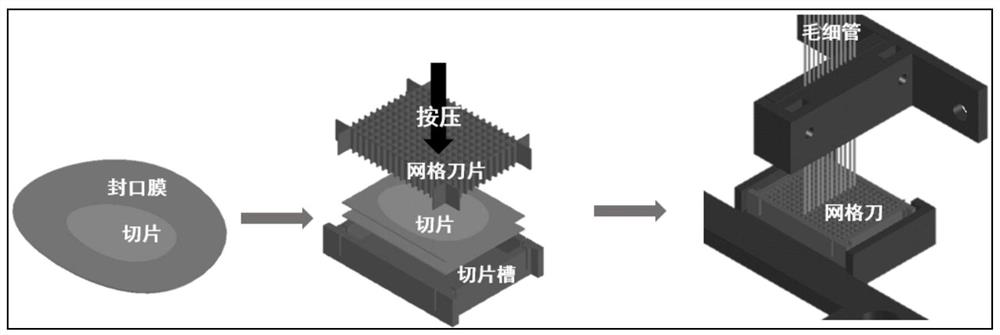Molecular imaging method based on high-stability capillary electrophoresis separation analysis technology
A technology of capillary electrophoresis and molecular imaging, which is applied in the fields of life sciences, pharmaceutical development and materials science, clinical medicine, and analytical chemistry. It can solve the problems of difficult application of mass spectrometry imaging, high operation requirements, and high maintenance costs, and achieve wide separation of objects and easy operation. Simple, easy-to-scale effects
- Summary
- Abstract
- Description
- Claims
- Application Information
AI Technical Summary
Problems solved by technology
Method used
Image
Examples
Embodiment 1
[0055] 1. Use a grid knife to perform pretreatments such as uniform cutting, in situ extraction, and fluorescence derivatization of tissue sections
[0056] Such as figure 1 The schematic diagram of the operation of the sample pretreatment method of the grid knife tissue section is shown, taking the mouse brain tissue section as an example, and the specific operation includes the following steps:
[0057] 1. Lay freshly obtained cryosections of mouse brain tissue on a clean parafilm.
[0058] 2. Trim the parafilm to a size that matches the size of the slicing groove, and place it on the bottom of the slicing groove with two layers of sealing film as a whole, add the hydrophobized grid blade, and press down to make the slice evenly Divide and compartmentalize into miniature square wells.
[0059] 3. There is no need to transfer the cut slices, because the micro-wells of the grid knife are like micro-containers, which play a role of separation. Add 1.5 μL reagent directly to ...
PUM
 Login to View More
Login to View More Abstract
Description
Claims
Application Information
 Login to View More
Login to View More - R&D
- Intellectual Property
- Life Sciences
- Materials
- Tech Scout
- Unparalleled Data Quality
- Higher Quality Content
- 60% Fewer Hallucinations
Browse by: Latest US Patents, China's latest patents, Technical Efficacy Thesaurus, Application Domain, Technology Topic, Popular Technical Reports.
© 2025 PatSnap. All rights reserved.Legal|Privacy policy|Modern Slavery Act Transparency Statement|Sitemap|About US| Contact US: help@patsnap.com



